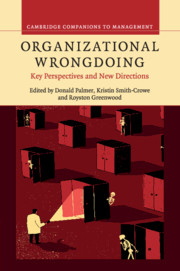Book contents
- Frontmatter
- Contents
- List of figures
- List of tables
- List of contributors
- Foreword
- 1 The imbalances and limitations of theory and research on organizational wrongdoing
- 2 On taking the theoretical substance of outcomes seriously: a meta-conversation
- 3 Wrong paths to right: defining morality with or without a clear red line
- 4 From market enablers to market participants: redefining organizational and political-legal arrangements and opportunities for financial wrongdoing,1930s–2000
- 5 Wrongdoing and market development: an examination of the distinct roles of trust and distrust
- 6 Bad apples, bad barrels and bad cellars: a “boundaries” perspective on professional misconduct
- 7 S/he blinded me with science: the sociology of scientific misconduct
- 8 Social networks and organizational wrongdoing in context
- 9 Falling stars: celebrity, infamy, and the fall from (and return to) grace
- 10 Compensation and employee misconduct: the inseparability of productive and counterproductive behavior in firms
- 11 Beware of organizational saints: how a moral self-concept may foster immoral behavior
- 12 “Is it me? Or is it me?” The role of coactivated multiple identities and identifications in promoting or discouraging workplace crimes
- 13 Consequences of organizational misconduct: too much and too little punishment
- 14 Who bears the brunt? A review and research agenda for the consequences of organizational wrongdoing for individuals
- 15 Organizational wrongdoing and media bias
- 16 Ethical learning: releasing the moral unicorn
- Index
- References
12 - “Is it me? Or is it me?” The role of coactivated multiple identities and identifications in promoting or discouraging workplace crimes
Published online by Cambridge University Press: 05 July 2016
- Frontmatter
- Contents
- List of figures
- List of tables
- List of contributors
- Foreword
- 1 The imbalances and limitations of theory and research on organizational wrongdoing
- 2 On taking the theoretical substance of outcomes seriously: a meta-conversation
- 3 Wrong paths to right: defining morality with or without a clear red line
- 4 From market enablers to market participants: redefining organizational and political-legal arrangements and opportunities for financial wrongdoing,1930s–2000
- 5 Wrongdoing and market development: an examination of the distinct roles of trust and distrust
- 6 Bad apples, bad barrels and bad cellars: a “boundaries” perspective on professional misconduct
- 7 S/he blinded me with science: the sociology of scientific misconduct
- 8 Social networks and organizational wrongdoing in context
- 9 Falling stars: celebrity, infamy, and the fall from (and return to) grace
- 10 Compensation and employee misconduct: the inseparability of productive and counterproductive behavior in firms
- 11 Beware of organizational saints: how a moral self-concept may foster immoral behavior
- 12 “Is it me? Or is it me?” The role of coactivated multiple identities and identifications in promoting or discouraging workplace crimes
- 13 Consequences of organizational misconduct: too much and too little punishment
- 14 Who bears the brunt? A review and research agenda for the consequences of organizational wrongdoing for individuals
- 15 Organizational wrongdoing and media bias
- 16 Ethical learning: releasing the moral unicorn
- Index
- References
Summary
While corporate crime is unfortunately not a new phenomenon, high-profile abuses in the last decade have led to a renewed urgency in understanding the precursors of wrongdoing in organizations. In this vein, academic research has recently begun to adopt an identity perspective, especially from social identity theory, to explore the antecedents of ethical misconduct in organizations. Apart from looking at one's moral identity (see Ashforth and Lange, this volume), recent research suggests that organizational identification (i.e., viewing one's role in the organization as self-defining) will influence a person's propensity to engage in workplace crimes (May, Chang, and Shao 2015; Umphress, Bingham, and Mitchell 2010; Vadera and Pratt 2013). Common to these social identity-based perspectives on wrongdoing is a focus on a single identity or identification (e.g., moral identity or organizational identification). However, scholars have long understood that in addition to social identities, any given individual may have a multitude of role identities – tied to various internalized roles he or she plays in society (e.g., parent, accountant, soccer player) – which may be brought to bear in a given social situation (Burke 2003; Stryker and Serpe 1994). In organizational studies, research further suggests that individuals do bring to and express these different identities (e.g., religious, kinship) at work (Ashforth and Pratt 2003; Creed, DeJordy, and Lok 2010; Fitzsimmons 2013; Kreiner, Hollensbe, and Sheep 2006; Pratt and Rafaeli 1997; Ramarajan and Reid 2013). There have even been recent and urgent calls in the popular press for organizations to allow people to bring more of their “whole self” (the self is comprised of multiple identities) to work (e.g., backwest.com/life-back-west-may-2012-bring-your-whole-self/). But how might these multiple identities and identifications influence decisions about whether or not to engage in workplace crimes?
In this chapter, we build off research that ties organizational attachments to workplace crime by articulating how the activation of nonorganizational role identities may function in conjunction with organizational identification to influence a person's propensity to commit workplace crimes. We argue that the activation of multiple identities (or identification with multiple social groups and roles) and identity content (i.e., the type of social group or role activated) play a role in either mitigating or strengthening the relationship between someone's identification with the organization and his/her propensity to engage in illegal or unethical behaviors at work.
- Type
- Chapter
- Information
- Organizational WrongdoingKey Perspectives and New Directions, pp. 337 - 369Publisher: Cambridge University PressPrint publication year: 2016
References
- 3
- Cited by



